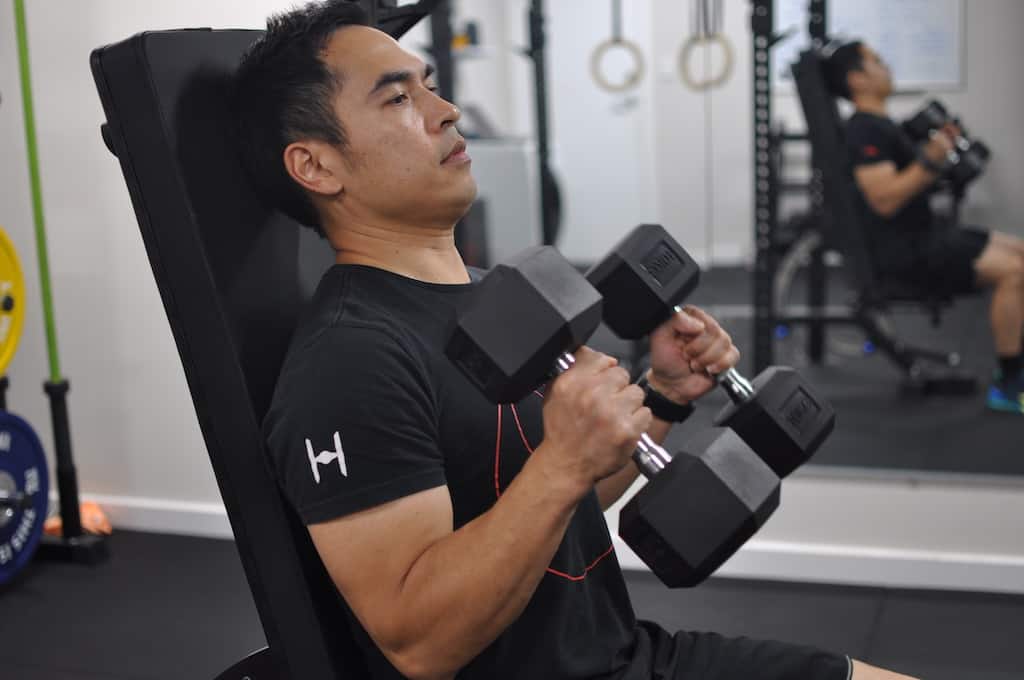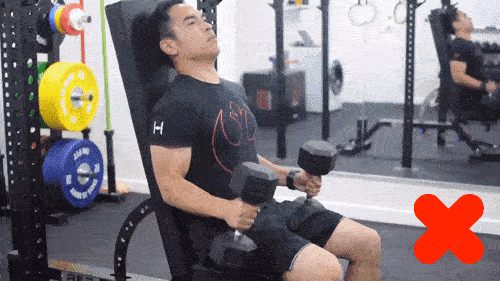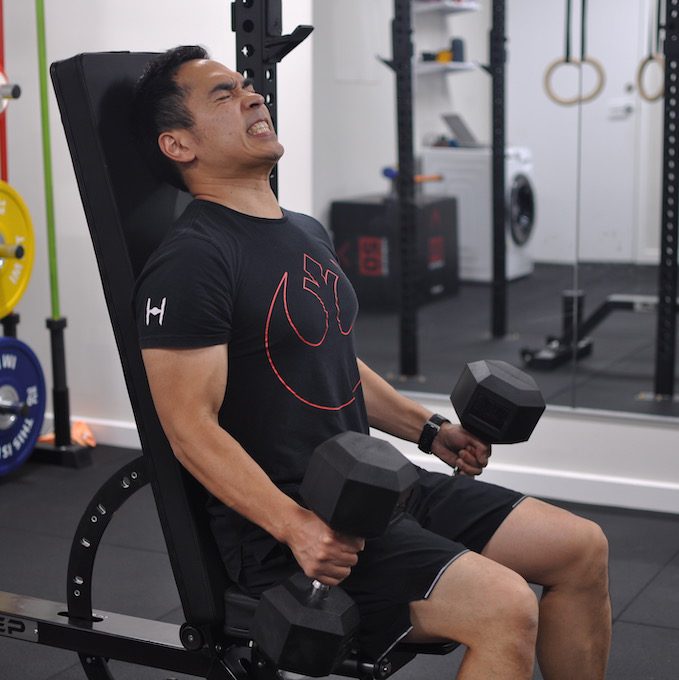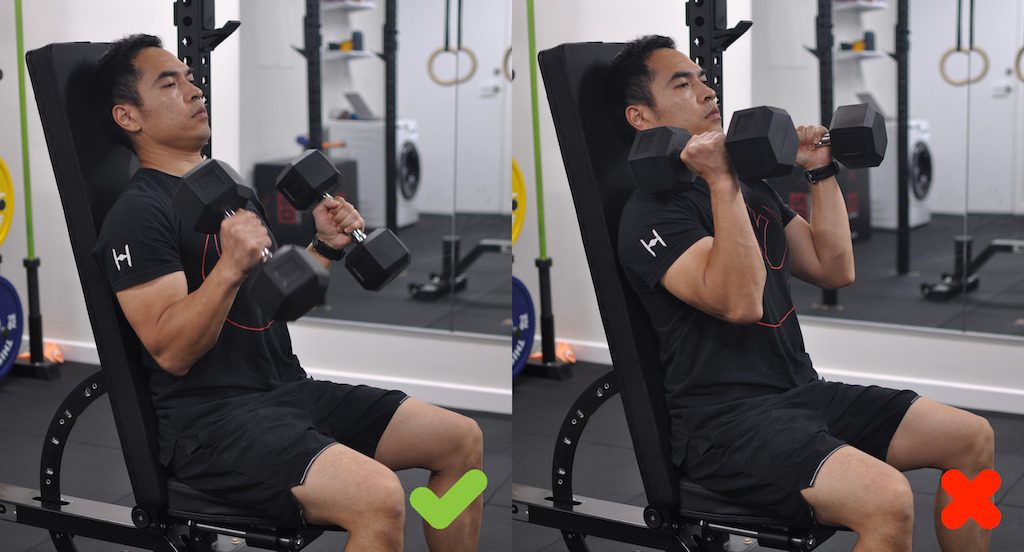
The best online fitness resource you'll ever need. We filter out the BS to ensure you meet your health and fitness goals!

The best online fitness resource you'll ever need. We filter out the BS to ensure you meet your health and fitness goals!

For reasons we will explain here, seated hammer curls are biomechanically one of the best hammer curl variations for isolating the target muscles and setting them up for hypertrophy. The cable hammer curl may be the only contender as better.

Seated hammer curls require a seat of some sort, as the name makes obvious, and dumbbells. The lifter has the luxury of selecting any available seat, with or without a back.
Utility benches–the short benches with backs frequently used for dumbbell shoulder presses–are probably the best suited. An incline bench would make a fine seat, but then that turns the seated hammer curl into an incline hammer curl.
The seat makes cheating more difficult, which is one of the two top reasons why seated hammer curls are such a good pick for arms.
Seated hammer curls can be done single sided, both arms curling simultaneously, or alternating arm to arm.
Seated hammer curls work the biceps, the brachio-radialis, and the brachialis in isolation when performed properly.

The brachioradialis is that upper arm muscle that creates that bulge on the outer elbow when flexed and adds height to the arm when bent.
The brachialis adds height and width to the upper arm and because of its location. That little pronounced golf ball bulge on the outside of the upper arm? That’s the brachialis.
Hammer curls preferentially work the brachioradialis a bit more than palms-up versions do because it is aligned perpendicular to gravity.
The biceps are also worked anytime the forearm moves toward the body. The biceps insertion on the forearm isn’t quite as aligned with resistance as is the brachioradialis.
To build a thick, muscular elbow and outer upper arm area, seated hammer curls are great.
Hammer curls of all sorts are a bit more tendon-friendly than palms up or palms down versions since the biceps tendons are not stretched as far from origin at the shoulder to their attachment on the radius (thumb-side forearm bone).
To do a proper seated hammer curl:

Hammer curls make good form easier than doing some hammer curl variations, but screwing them up is still possible. Common hammer curl mistakes can be made seated as well.

Arresting the range of motion so that you’re short-stroking each rep only partially works the target muscles. Do partial reps create lactic acid burn? Yes, they do, and a novice lifter will believe that alone signals the onset of hypertrophy. Lactic acid is a metabolic byproduct that creates “burn” regardless of whether conditions for hypertrophy are being created or not. Burn does *not* mean muscle size is being affected.

If the shoulder is moving, you’re not doing a proper seated hammer curl. The elbow should be the only joint that moves and the upper arm should look like it’s made of cement. No movement. None. Anything else is cheating.

Using weights that are too heavy so that they compromise form. Work your arms not your ego.
This is similar to swinging the dumbbells above. Any extra body movement that generates momentum is a mistake. Sitting makes this error more difficult to commit but doesn’t prevent it completely.

As we’ve emphasized above, the humerus (upper arm bone) should remain locked in a vertical position. An all-to-common mistake is for the lifter to move the elbow forward as one might if they were running.
The elbow comes forward and that means that the hand and dumbbell would cross vertical and “fall” back under its own weight and with no help from the lifter.
Ergo, no work is being done for almost half the lift. No muscle building results can be expected from this type of form.
Seated hammer curls have an advantage over other hammer curl variations due to their ability to mitigate common mistakes, primarily using the hips and legs as locomotion. The seat and use of dumbbells add the following biomechanical benefits.
Seated hammer curls are more challenging near the bottom of each rep when the muscle is able to generate the most force, and recruit muscle fiber.
The lift maintains a degree of challenge throughout so long as the lifter doesn’t lean backward, causing the weight to “fall back” to the shoulder as it passes over the point vertical to the floor.
As long as the lifter adds no momentum and uses strict form to raise and lower the weight, time under tension is almost constant.
Stopping the weight short a degree or two (not 20 or 30 degrees) before the arm completely straightens can increase the time under tension.
The slight lean backward when a utility bench keeps the dumbbell from cresting at the top where the weight is perpendicular to the floor (and the arms are working almost not at all). The weight is kept somewhat shy of straight up and down and so the target muscles stay loaded.
Seated hammer curls allow for a full range of motion. For the lifters who are able to strictly lift big, heavy dumbbells, the head of the dumbbell can prevent a 100% full range of motion, but so can big muscular upper arms.
Suffice it to say that the ROM for seated hammer curls is very good unless the lifter performs partial reps (which as we’ve already said have negligible muscle-building benefit).
The biceps are more easily inflamed from overuse injury or injured during palms-up grip curls, especially when the beginning position for the curl places the tendon under great load in a mechanically disadvantageous position.
Free weight preacher curls are the best example for a curl variation that incurs this kind of risk.
Seated hammer curls (as well as hammer curls of all sorts) make more use of the brachio-radialis and therefore share the load more evenly with the biceps.
And, because the brachio-radialis attaches farther down the arm, there is additional mechanical advantage due to improved leverage.
Drawbacks to the seated hammer curl? None that we can think of.
The strictness that the seat enforces along with the upper body position relative to the floor makes the seated hammer curl an excellent option to work the anterior upper arm muscles.